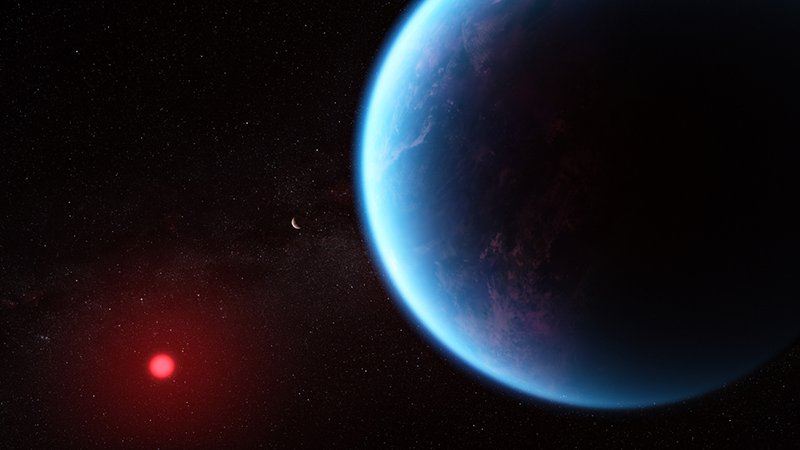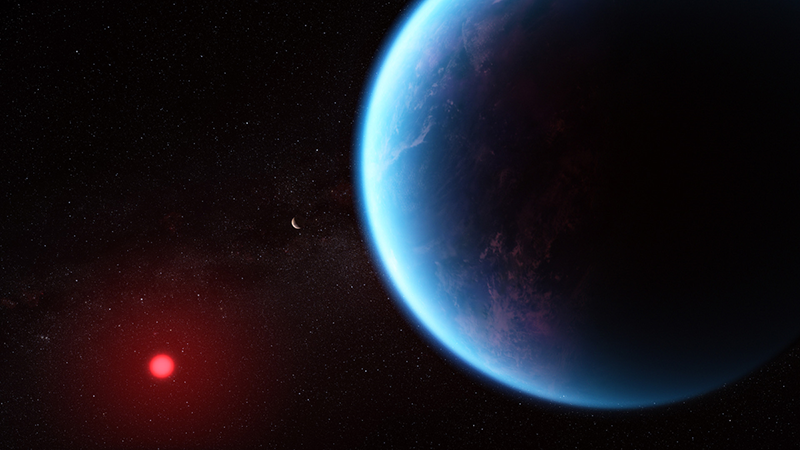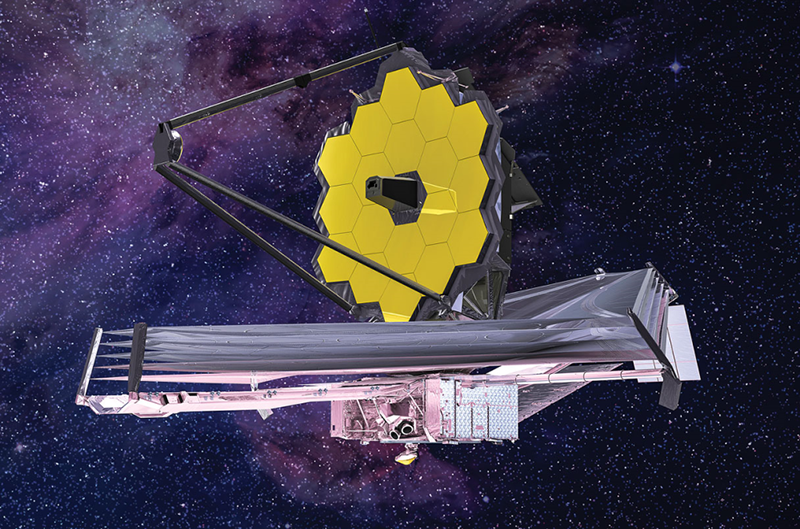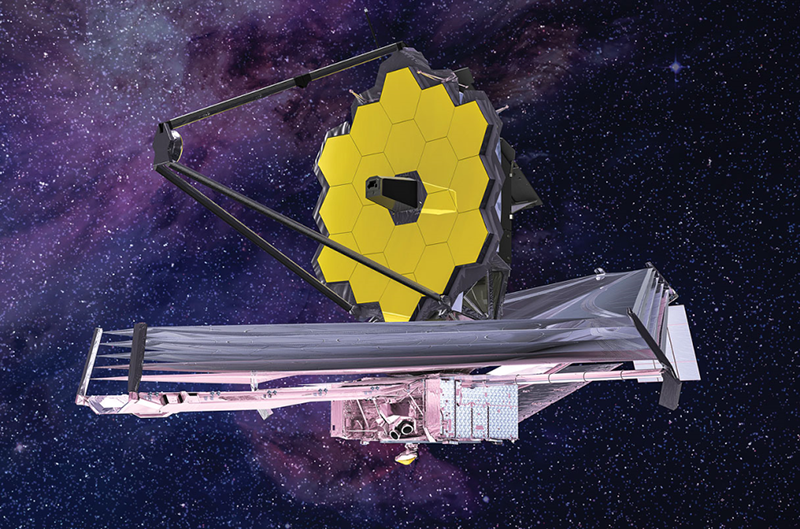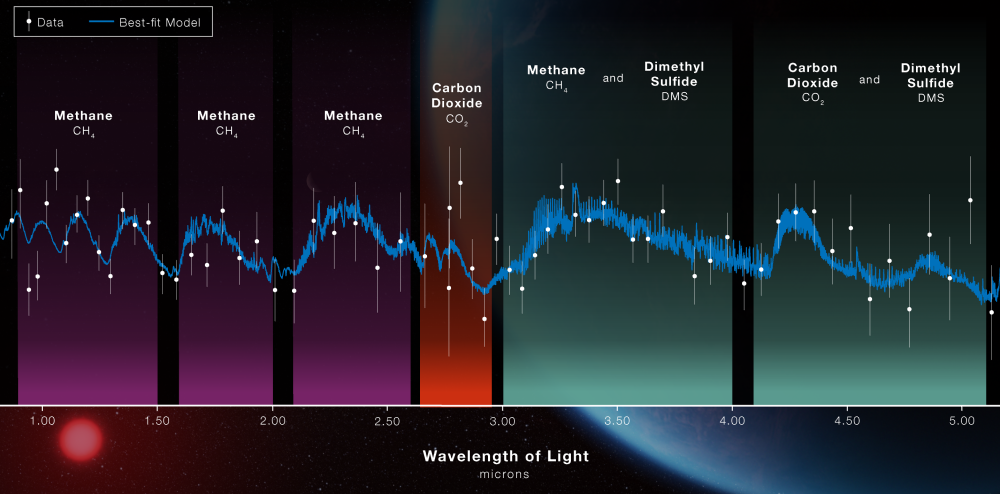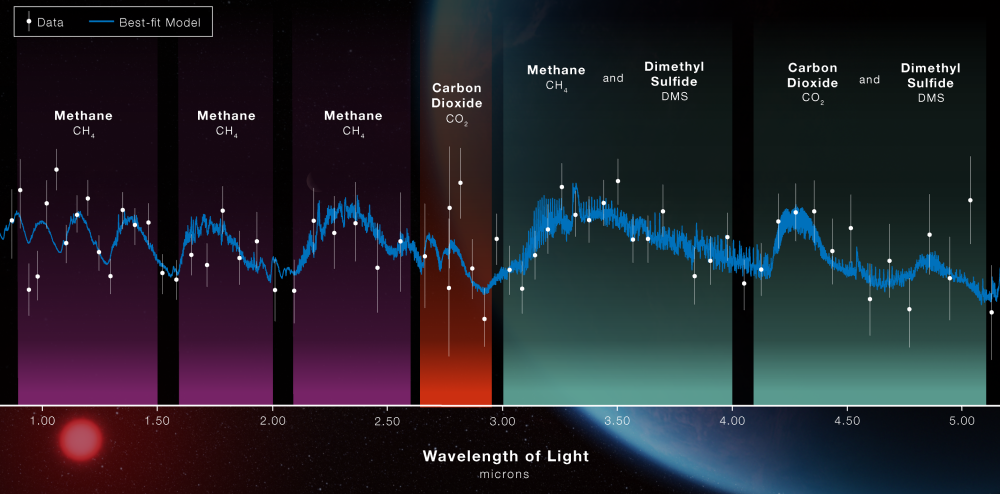The Skinny on Detecting Life with the JWST
Last month, scientists using the JWST observatory announced that they had uncovered a habitable-zone ocean planet about 8.6 times the mass of Earth [1]. The news sparked headlines across the globe as journalists grabbed on to a secondary result—hints that the planet’s atmosphere contains a molecule consistent only with life. Other scientists, while reasonably convinced by some of the study’s findings, quickly shared their skepticism that the team behind the study had found life.
One reason for the disbelief is the low statistical significance of the detection of the molecule in question, dimethyl sulfide (DMS). “The conclusion that they found this molecule is about as likely as a conclusion that they didn’t,” says Ryan MacDonald, an astrophysicist at the University of Michigan and a user of JWST data. Another issue is the lack of evidence that DMS can come only from a living thing; on Earth it is made by marine algae and released by cabbage when it is cooked. But that doesn’t mean that the molecule has a biological origin elsewhere, says Jo Barstow, who models the structures of planetary atmospheres at the Open University, UK.
Nikku Madhusudhan, an astrophysicist at the University of Cambridge and a member of the team reporting the ocean-planet results, accepts that the finding regarding DMS is inconclusive. He says that the team decided to mention the DMS inference in the announcement because of its nonzero signal and its potential as a biosignature. “The result is very tentative, but there still seems to be something there,” he says.
This case highlights the possibilities—and challenges—that surround the search for molecular signatures of life on distant worlds. The JWST offers astronomers new capabilities that are sure to reveal plenty of tantalizing tidbits about exoplanet atmospheres. Will one of them provide a “smoking gun” signal of life outside of Earth? Maggie Thompson, an astrophysicist at the Swiss Federal Institute of Technology (ETH) in Zurich who studies planetary sources of methane, is dubious that such a smoking gun exists. “I don’t think that there will ever be one molecule that if we see it, we will say ‘yes, life,’” she says. But there are molecular combinations that she would be willing to call “definitely, maybe life.” As some of these combinations are potentially detectable with the JWST, planetary scientists remain optimistic about future announcements that might report on biologically suggestive atmospheres.
K2-18b
The planet at the center of the current life debate is K2-18b. It was first captured by the Kepler space telescope in 2015 and was the 1825th exoplanet discovered, according to a NASA database. The radius of K2-18b lies between those of Earth and Neptune, and its orbit sits inside the habitable zone of its host star, meaning that it has the potential to support liquid water. Four years ago, using the JWST’s older sibling, the Hubble Space Telescope, scientists thought they had found water in K2-18b’s hydrogen-rich atmosphere. That claim was strongly debated and subsequently rolled back, based on ambiguities in the identification of molecules in the wavelength range over which Hubble operates.
The newer JWST can pick up signals 100 times fainter than those visible with Hubble. It can also monitor much longer wavelengths, a capability that allows JWST to better identify some molecular signatures. Indeed, the JWST observations determined that signals previously attributed to water in K2-18b’s atmosphere were actually evidence of methane. The telescope has similarly identified methane features in the gas giant known as WASP-80b [2].
“Methane has been really hard to find in [exoplanet] atmospheres,” says Caroline Morley, an astrophysicist at the University of Texas, Austin, who simulates planet atmospheres. “The [K2-18b] methane detection seems to be robust, and the one for WASP-80b appears rock solid.”
The Importance of Methane
Like water on a planet’s surface, methane in the atmosphere is considered a sign that the planet might host life. That’s because of the molecule’s short atmospheric lifetime—in Earth’s atmosphere it typically oxidizes into water vapor and carbon dioxide in just 7–12 years. So if scientists spot the molecule in a planet’s atmosphere, something on that planet is probably producing it.
On Earth that something is predominantly life. Nearly all of Earth’s methane is biogenic—it was produced either directly by a living thing (mostly as a by-product of animal digestion) or indirectly by the decay of organic matter. But methane also belches from volcanoes, outgasses during chemical reactions within rocks, and appears after a comet or asteroid impact. Thus, methane alone is not enough to claim a planet hosts life.
Thompson and her colleagues have, however, investigated mixtures of methane and other gases that might be harder to explain with geochemistry alone. They found that a potential biosignature would be an upper atmosphere containing methane and carbon dioxide, but no oxygen or hydrogen, and little or no carbon monoxide [3]. Models indicate that such a gas combination can arise when a planet’s methane originates on its surface, where scientists think life will reside.
“Together those observables would make me very excited,” Thompson says. “But we’d still have to do a lot of follow up studies.” Barstow agrees. “There is still a huge amount we don’t know about the chemical reactions going on inside exoplanet atmospheres,” she says. “We have to be really sure we’ve thought of every possible origin of a molecule before we can say it comes from life.”
The methane observed on K2-18b is not likely to be of biologic origin. Past and present observations indicate that K2-18b’s atmosphere is hydrogen dominated, and such an environment can produce methane through photochemical reactions between hydrogen and carbon.
The Hidden Ocean
Even with that conclusion, Thompson says that the K2-18b methane detection is still very interesting. That’s because Madhusudhan and his colleagues don’t see methane alone. Their analysis indicates that K2-18b’s atmosphere also contains carbon dioxide, with both molecules existing at roughly the 1% level. Methane is carbon’s most reduced form—it contains no oxygen; carbon dioxide is its most oxidized form—it contains the most oxygen per carbon of any organic compound. Thompson says that simultaneously seeing both of these molecules suggests that the atmosphere may be in chemical disequilibrium, a conclusion that scientists can use to potentially glean additional information.
For K2-18b, Madhusudhan and his colleagues claim that the source of the atmosphere’s disequilibrium is a planet-spanning ocean. The team reports methane and carbon dioxide detections with high statistical confidence, but they also report “nondetections” of ammonia and water, which at first glance may seem odd for a water-rich world. But the JWST only probes the upper echelons of a planet’s atmosphere. The team’s model indicates that water swirls below the hydrogen, and the nondetection of ammonia fits with that prediction—the ocean acts as a sink for the pungent gas, effectively sucking it out of the atmosphere.
Reaching this conclusion required a multistage analysis of the JWST data, and it is this analysis that has made other scientists cautious about the team’s interpretations. The JWST captures the signals of exoplanets using the so-called transit method, the workhorse technique of the field. When a planet passes in front of its star, the star’s light is slightly diminished. The brightness reduction depends on the planet’s size and its upper atmosphere’s composition, so scientists can infer both types of information from such measurements.
Going from the JWST’s raw data to a list of gases is a complicated process. Scientists create a spectrum from the transiting event and compare it with computer models that simulate spectra for different planetary and atmospheric conditions. “We explore millions of combinations of molecules and properties of planets, such as temperature and cloud coverage, until we find something consistent with the observations,” MacDonald says.
However, not all models give the same results. Ideally, researchers work out the discrepancies by performing independent cross-checks on the same dataset. But not all of the JWST’s data are in the public domain, as some targeted observations remain private to the group that collected them for a year. For the K2-18b observations of Madhusudhan and colleagues, the data will start being released in January of next year. Until then, much of the planetary research community remains uncertain about the team’s results. “The conclusion of the ocean rests on the detection of methane and the calculation of its abundance,” MacDonald says. “If independent teams—starting with the raw data—also see the same methane and carbon dioxide features and measure the same abundances, then we will be much more confident that the finding is real.”
JWST’s Detectors
In addition to the ocean claim, planetary scientists urgently want to check the DMS revelation, which even Madhusudhan says sits on shaky ground. The finding has low statistical confidence (between 1 and 2 sigma) and depends on how the team models the JWST’s detectors: only two of the detectors picked up the possible DMS signal, and earlier observations indicate that these two detectors have slightly different sensitivities. There’s also some uncertainty over how the team dealt with fluctuations in the star’s output from things like flares and sunspots. “The appearance of the molecule is highly sensitive to the precise way the team treats the data,” Barstow says. “When a finding is that sensitive to the details, it’s hard to say it’s valid.” She adds that future characterization tests of the detectors, along with modeling, should resolve the uncertainties.
The methane detection holds steady in all of the team’s models—and it’s the methane finding that Madhusudhan is most excited about, even if it was the tentative DMS signal that drew widespread attention to K2-18b. “The search for habitability and biosignatures is fixated on small rocky planets. But nature has no preference for making these worlds—exoplanets are extremely diverse in composition,” he says. K2-18b is just over half as big as Neptune, and signs point to it not being rocky. “Here we find a planet in the habitable zone that doesn’t fit the Earth-like mold and that could support life,” Madhusudhan says. “That is huge.”
More JWST observations of K2-18b are planned for later this year. Scientists hope that these observations will clarify the molecules in its atmosphere one way or another. But whatever the debate’s outcome, researchers are happy that they are even able to have it. Measurements of planets the size of K2-18b and smaller were previously tricky because of the very tiny amount of light that they block. And methane detections have been oddly absent. But with the JWST, both types of measurements will likely become routine. “For the very first time in history we have the technology to look for molecules in the atmospheres of exoplanets down to the size of Earth,” MacDonald says. “Who knows what we will find.”
–Katherine Wright
Katherine Wright is the Deputy Editor of Physics Magazine.
References
- N. Madhusudhan et al., “Carbon-bearing molecules in a possible hycean atmosphere,” arXiv:2309.05566.
- T. J. Bell et al., “Methane throughout the atmosphere of the warm exoplanet WASP-80b,” arXiv:2309.04042.
- M. A. Thompson et al., “The case and context for atmospheric methane as an exoplanet biosignature,” Proc. Natl. Acad. Sci. U.S.A. 119 (2022).



